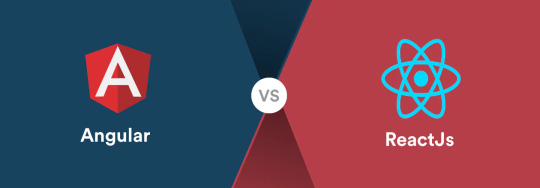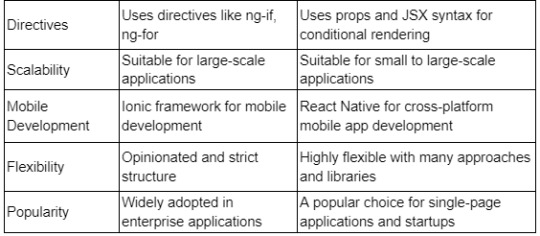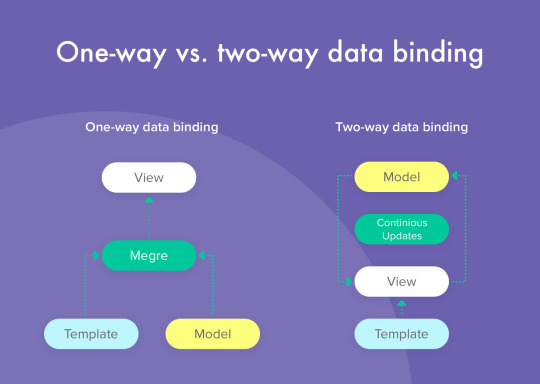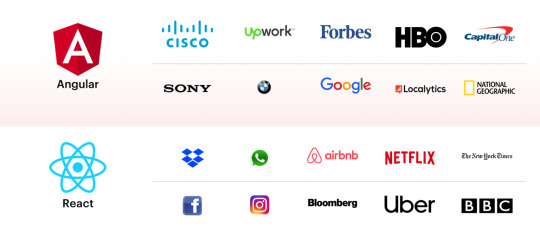#IsReactorAngularmoreindemand
Explore tagged Tumblr posts
Text
Which is More Powerful, AngularJS or ReactJS?
Today, businesses seek tools and frameworks to build dynamic and engaging user interfaces.
The two prominent web app frameworks that are extremely used are- AngularJS and ReactJS. Each framework has unique strengths and specialties, catering to diverse project requirements and offering advanced tools and features to build modern-age web applications.
Whether you are a beginner or an experienced developer, you must understand these two popular frameworks, AngularJS vs. ReactJS.

Source- https://www.simform.com/blog/angular-vs-react/
In this blog, we will explore the common differences: Angular vs. Reactjs and where to use which framework.
Reactjs: Learn Once, Write Anywhere
ReactJS is a powerful JavaScript library for building user interfaces in web applications. It's known for its efficiency and uses a component-based approach, making UI development straightforward and organized.
React's virtual DOM ensures fast rendering by updating only the necessary parts of the webpage. JSX simplifies writing HTML within JavaScript, improving code readability. With one-way data binding, React ensures predictable data flow, making it easier to maintain and debug applications. These features make ReactJS a popular choice among developers for creating responsive and dynamic web interfaces.

Source- https://bestofjs.org/projects/react
Key features-
Declarative views
JSX advantage
Component-based
Virtual DOM
One-way data binding
Building blocks flexibility
Advantages of Reactjs-
ReactJS provides several benefits:
Developers can create reusable and predictable code.
Debugging is simplified with declarative views.
It reduces ReactJS Developer development time significantly.
It enhances developer productivity.
Transitioning between different React versions is seamless.
React Native facilitates mobile app development.
Updates are faster with server-side and front-end rendering support.
The UI is efficiently built for improved load times and performance.
It integrates smoothly with various third-party libraries and tools.
Hire the best Hire Reactjs Developers from OnGraph for advanced interfaces.
What is Angular?
Angular is a robust platform and framework for web development, built using TypeScript. It uses a component-based architecture to create scalable web applications. Angular accelerates front-end development with integrated libraries for tasks like client-server communication and routing. It comes with tools that work well for projects of any size, from small apps to large enterprise ones.

Source- https://bestofjs.org/projects/angular
Key features-
Two-way data binding
Dependency injection
Virtual scrolling
Angular CLI
Built-in libraries
Advantages of Angular-
It promotes strong encapsulation and follows an intuitive application structure.
Facilitates clean code development, enhancing maintainability.
Simplifies building, testing, and updating applications.
Includes built-in features like RxJS and Angular CLI for efficient development.
Built-in support for HTTP, AJAX, and Observables streamlines data handling.
Enables rapid server-side rendering and supports views without browser-side rendering.
Parallel component execution reduces the lines of code needed.
Boosts developer productivity and enhances application performance overall.
Also read: 13 Best React Frameworks and Libraries to Use in 2024
Angular vs. ReactJs: Tabular Difference


Detailed Comparision: Reactjs vs. Angular
1. Popularity
Both Angular and React have gained popularity in the developer community. React leads with 203k stars on GitHub and ranks second in a 2022 Statista survey on the most used web frameworks worldwide.
Angular, initially released as AngularJS, gained fame for single-page applications. Its redesign as Angular 2 in 2016 introduced new features, solidifying its maturity. However, React's rendering optimizations, virtual DOM, and easy component reuse have consistently made it the preferred choice for dynamic web applications.
2. Performance
Both Angular and React excel in building high-performing web applications, each with its unique strengths.
Angular prioritizes optimizing coding practices and performance enhancement through features like optimized digest cycles and $cacheFactory for efficient data memorization and recalculation. It uses real DOM with a sophisticated change detection mechanism that accelerates web app rendering.
On the other hand, React leverages its virtual DOM, which enables faster updates and data refreshes without rewriting the entire HTML document. It promotes component reusability across projects, enhancing developer productivity and maintaining code quality. These capabilities ensure both frameworks deliver efficient, scalable solutions for varying project complexities.
Hire a React JS development company for next-level React JS development services.
3. Data Binding

Source- https://www.tabnine.com/blog/angular-vs-react/
Angular and React handle state management differently. Angular uses two-way data binding, meaning changes in interface elements automatically update the model and vice versa. This simplifies building interactive interfaces without extra callbacks, making it ideal for complex applications like ERPs.
React, on the other hand, employs one-way data binding, where updates to the interface occur after the model state changes. This gives developers more control but requires managing state with libraries like Redux for complex applications. While Angular automates data binding, React provides flexibility with precise control over the application state.
4. Server-side Rendering
Angular: With server-side rendering, Angular pre-renders the application to create a static view before it becomes fully interactive. It optimizes server-side performance by efficiently using JSON and client-side caching, minimizing client-server communication.
React: React supports server-side rendering easily, making applications more SEO-friendly. It uses functions like RenderToString for this purpose, offering flexibility that sets it apart from other JavaScript frameworks.
5. Testing
Angular: Testing in JavaScript can be challenging due to its dynamic typing, requiring thorough testing to ensure code quality. Angular simplifies testing with features like unit code isolation and dependency injection, which facilitate easy component decoupling and mocking. It offers comprehensive testing and debugging tools within a single framework setup.
React: Testing in React involves mocking parts not present in testing environments to ensure reliable results, particularly in data-fetching scenarios. React provides predictable tests with robust mocking functions. It integrates test suites into the development process, using test runners like Mocha, Ava, and Jest for efficient test execution alongside ongoing development tasks.
6. Optimizing bundle size
The size of the initial bundle file downloaded when loading a webpage significantly affects how quickly the page displays. Both Angular and React developers focus on optimizing this bundle size for better application performance.
Angular: Angular applications require compilation before they can run in a browser. This compilation ensures that Angular's components and templates are understood by browsers. However, larger bundle sizes can slow down loading times. To speed up rendering, developers can use Ahead-of-Time (AOT) compilation. Although not the default, it can be activated through Angular CLI in production mode. AOT converts Angular's HTML and TypeScript code into efficient JavaScript during the build phase, improving load times.
React: Bundle size is crucial in React, especially as applications grow. It's essential to continually analyze and optimize the codebase to maintain performance. As new pages and features are added, the initial bundle size can increase significantly. Techniques like code-splitting and compression are vital for optimizing bundle sizes without slowing down the application. These methods help manage large app sizes effectively in React development.
7. Learning curve
Angular: Angular is extensive and dynamic. Initially, it covers fundamental topics like directives, modules, components, services, and dependency injection. Learning Angular may feel challenging at first due to its steep learning curve, especially compared to React.
React: React focuses on writing components, managing internal states, and using props for configuration. It may seem unfamiliar initially, but it's straightforward and doesn't add unnecessary complexity. Learning React's basics, along with state management and routing, prepares developers well for building applications.
Choosing between Angular and React depends on your project's requirements. Angular excels in solving complex problems in large-scale applications, while React's simplicity and flexibility have made it increasingly popular among developers. Both technologies offer robust features, tools, and performance capabilities, making it a tough choice for development teams.
When to Choose Angular vs. React
Angular
Angular excels in speeding up front-end development and is favored for creating robust, data-driven web applications. Maintained by Google, it offers stability and extensive community support. Here are scenarios where Angular is ideal for-
Designing, maintaining, and scaling large and complex applications due to its component and directive architecture.
Developing feature-rich elements and customizations efficiently.
Building enterprise-scale projects without needing extensive third-party integrations, could complicate development.
Choose Angular if you:
Need to create enterprise-grade applications with extensive features.
Manage projects of medium to high complexity.
Have developers skilled in languages like C#, Java, and Angular versions, ensuring high productivity.
Aim to develop applications like video streaming platforms, e-commerce sites, or real-time data apps.
React
React focuses on handling the view layer and excels in creating reusable UI components. It's known for its speed in updating data without reloading the page, originally developed by Facebook and widely adopted in large-scale applications like Instagram. Ideal use cases for React include:
Building customizable and interactive app solutions.
Creating apps with multiple events or shareable elements.
Projects where developers are proficient in JavaScript, HTML, and CSS.
Choose React if you:
Want to develop personalized applications tailored to specific needs?
Require dynamic and fast-loading interfaces for social networks, data dashboards, or retail apps.
Plan to build cross-platform mobile applications efficiently.
Understanding these distinctions will help you choose the right framework based on your project requirements and the development team's expertise.
Companies Using Angular vs. Reactjs

Source- https://www.simform.com/blog/angular-vs-react/
Angular or React - Which is Better?
Both Angular and React are widely used front-end technologies. While Angular offers great benefits, React stands out as the preferred choice. It has large community support and features like Virtual DOM and rendering optimizations that give it an edge over Angular.
React also makes version migration seamless and has a straightforward installation process. Overall, React streamlines development, reduces errors, and offers robust solutions. When choosing between React and Angular, consider your project needs and functionalities. For professional JavaScript development services, feel free to reach out to us confidently.
Connect with OnGraph, a leading React JS development agency for building exceptional front end and the best React JS development service.
Content Source URL: https://www.folkd.com/entry/56745-which-is-more-powerful-angularjs-or-reactjs/
#IsReactorAngularmoreindemand#ShouldIlearnAngularorReactin2024#reactjs#angularjs#DoesAngularorReactpaymore
0 notes